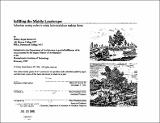Infilling the middle landscape : suburban zoning codes to retain historical place making forms
Author(s)
Bowen, Sidney Royal
DownloadFull printable version (10.66Mb)
Advisor
Ellen Dunham-Jones.
Terms of use
Metadata
Show full item recordAbstract
This thesis is a proposition for a new approach to the infill of the existing suburban context. While specific to a particular place and land use type, the rule making approach which is proposed and different from the existing is conceived as a general premise. That is, in place of the abstract functional rules which permeate the zoning regulations of Anytown, USA, I propose to substitute a rule making exercise aimed at retaining the historical characteristics of landscape and place which predate the increased density. The thesis seeks to demonstrate that maximum allowable density can be achieved while retaining the existing hierarchy of contiguous spaces and the relationship(s) of dwelling units to that hierarchy. The thesis emerges from a practical confrontation with the potential subdivision of a 1.6 acre property surrounding a 100 year old carriage house in suburban Beverly, Massachusetts converted to residential use 35 years ago. A brief critical history of the ongoing evolution of the American suburb and some precedents for architectural response to its shortcomings provides the basis for the design principals for this thesis which are then applied to two sites in Beverly. The goal is to accept the inevitable increase in density while developing and implementing a set of conditions at the neighborhood and house level that enhance the opportunity for continued enjoyment of Olmsted's notion of the "leisure, contemplativeness and happy tranquility" of the suburban ideal.
Description
Thesis (M. Arch.)--Massachusetts Institute of Technology, Dept. of Architecture, 1995. Includes bibliographical references (p. 73-75).
Date issued
1995Department
Massachusetts Institute of Technology. Department of ArchitecturePublisher
Massachusetts Institute of Technology
Keywords
Architecture